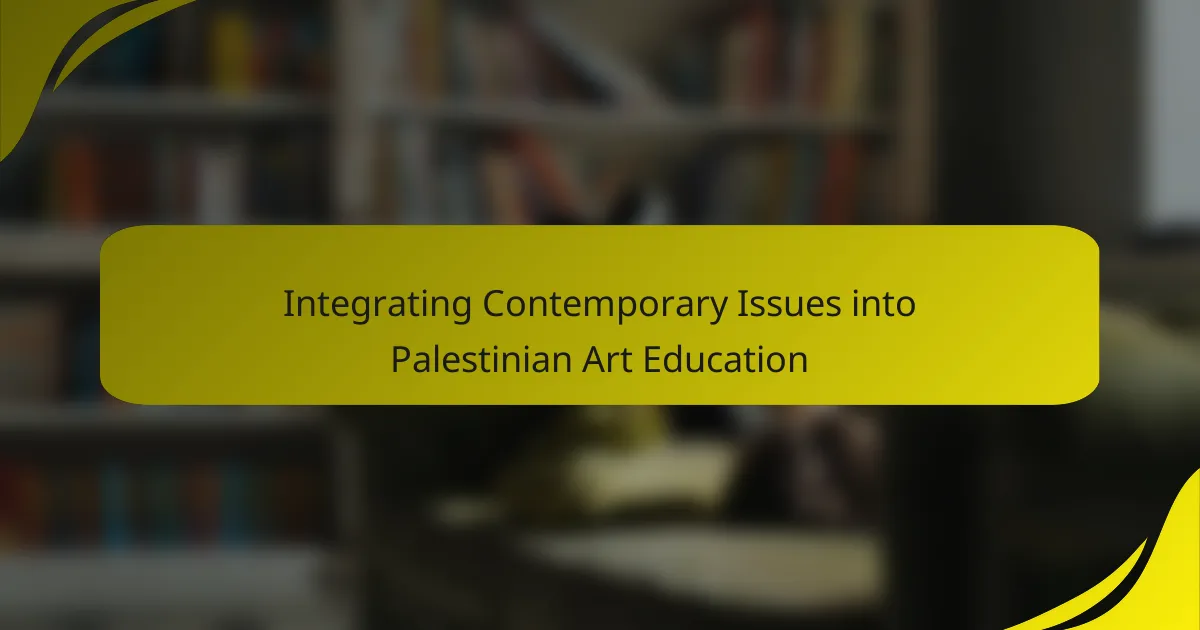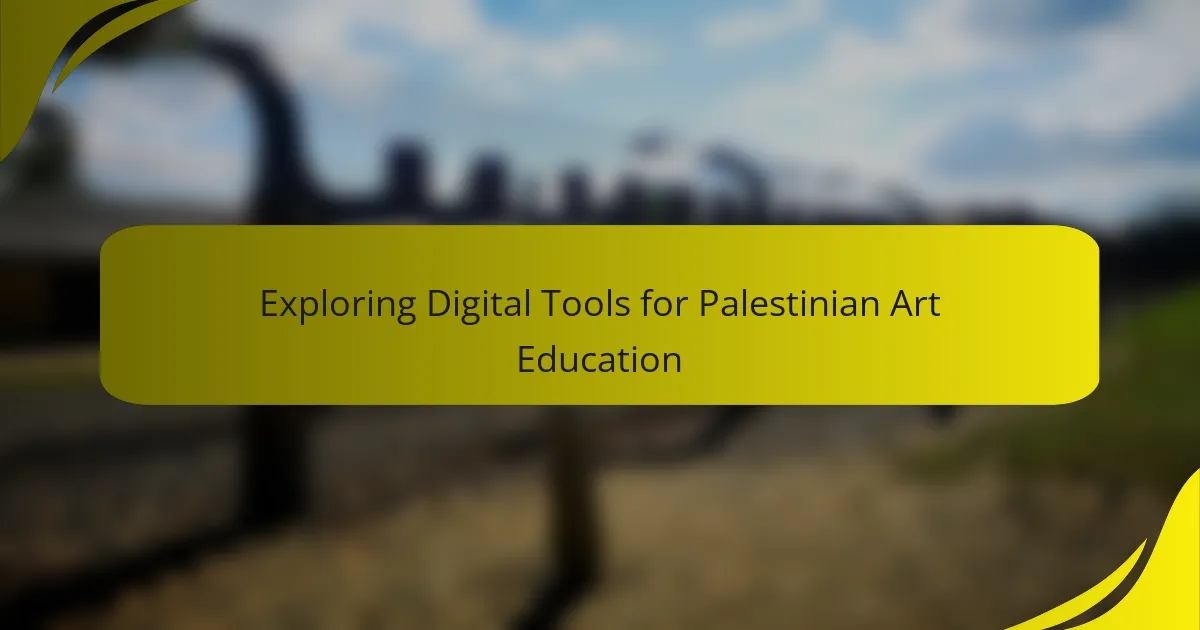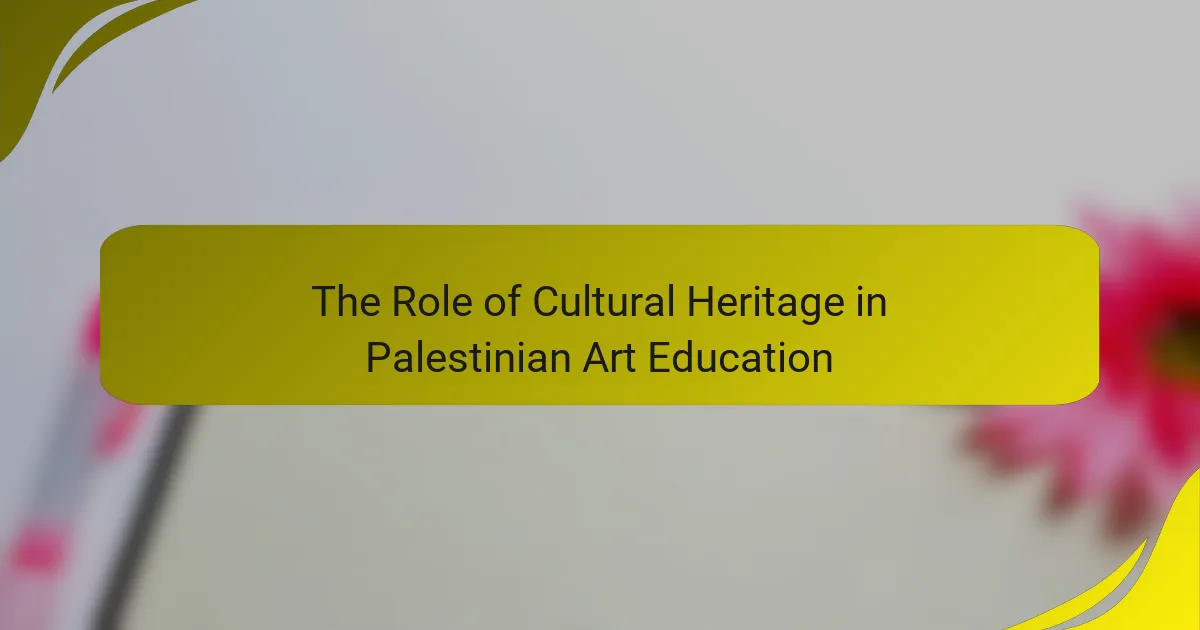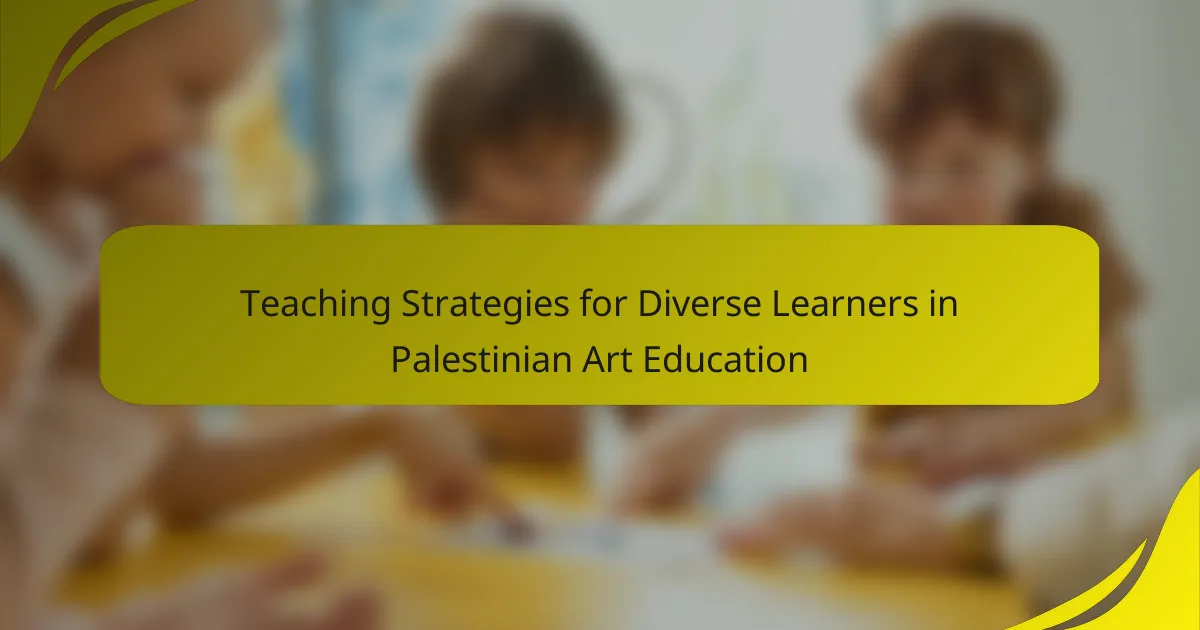Incorporating traditional techniques in Palestinian art education plays a crucial role in fostering cultural identity and heritage preservation among students. This approach enhances students’ understanding of their artistic roots while promoting creativity through various forms of expression. However, challenges such as resource limitations, a shortage of qualified instructors, and perceptions of traditional methods as outdated hinder effective integration. Strategies for overcoming these obstacles include hands-on workshops, collaboration with local artisans, and curriculum development that emphasizes historical context. By valuing and implementing traditional art techniques, educators can strengthen community ties and enrich students’ artistic experiences.
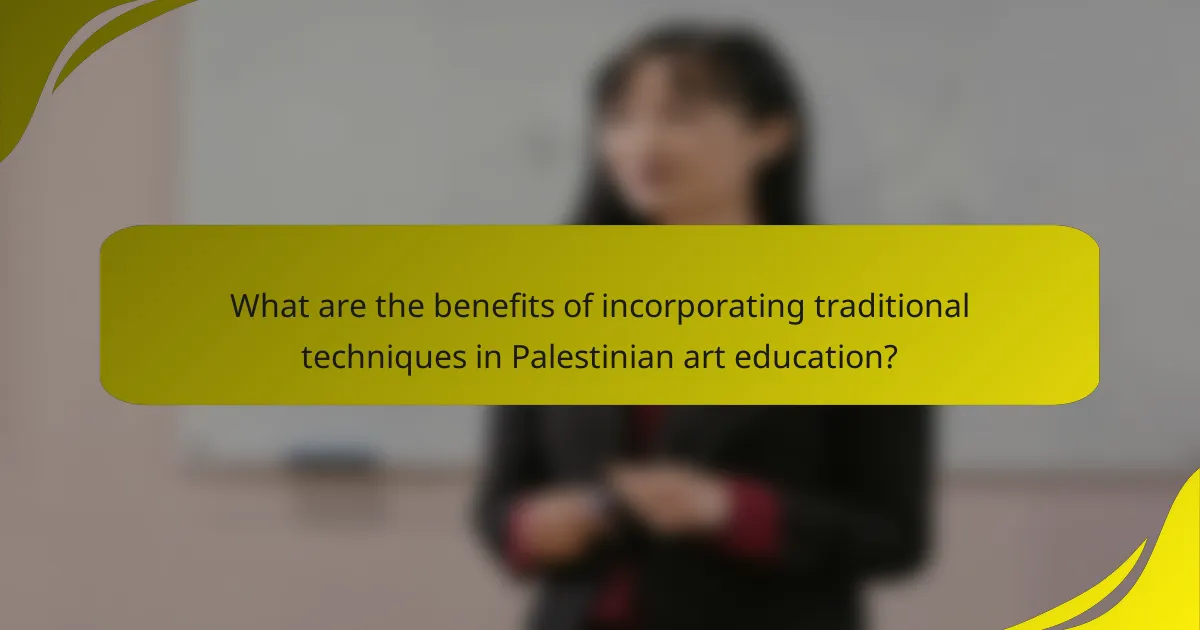
What are the benefits of incorporating traditional techniques in Palestinian art education?
Incorporating traditional techniques in Palestinian art education fosters cultural identity and preservation. It enhances students’ understanding of their heritage. Traditional methods offer unique artistic skills that are often overlooked in modern curricula. This approach promotes creativity by allowing students to explore various forms of expression. Additionally, it strengthens community ties through shared cultural practices. Research shows that students engaged in traditional art forms exhibit increased motivation and engagement. By valuing these techniques, educators contribute to the continuity of Palestinian artistic traditions.
How do traditional techniques influence creativity in Palestinian art education?
Traditional techniques significantly enhance creativity in Palestinian art education. They provide students with a rich cultural heritage to draw inspiration from. Techniques such as embroidery and ceramics are integral to Palestinian identity. These methods encourage experimentation and personal expression in students’ artwork. By learning traditional skills, students gain confidence in their creative abilities. The use of local materials fosters a connection to the environment. Additionally, traditional techniques promote collaboration and community engagement among students. This integration of heritage into art education leads to innovative interpretations of cultural narratives.
What specific traditional techniques are most impactful?
The most impactful traditional techniques in Palestinian art education include embroidery, pottery, and wood carving. Embroidery, particularly the tatreez technique, symbolizes cultural identity and storytelling. Pottery techniques, such as hand-thrown and painted ceramics, connect students to historical craftsmanship. Wood carving, often used in creating decorative items, showcases intricate designs rooted in tradition. These techniques enhance creativity and cultural appreciation among students. Studies indicate that engaging with traditional arts fosters a sense of belonging and identity in Palestinian youth.
How do these techniques foster artistic expression among students?
Traditional techniques foster artistic expression among students by providing a foundation for creativity. These methods encourage exploration of cultural heritage and personal identity. Students learn to manipulate materials and techniques unique to their culture. This hands-on experience enhances their ability to communicate emotions and ideas visually. Engaging with these techniques allows students to connect with their community and history. Research shows that art education improves critical thinking and problem-solving skills. A study by the National Endowment for the Arts highlights the positive impact of arts education on student engagement. Therefore, traditional techniques in art education cultivate both individual expression and cultural awareness.
Why is the preservation of traditional techniques important in art education?
The preservation of traditional techniques is crucial in art education because it fosters cultural identity. Traditional techniques connect students to their heritage and history. They provide a foundation for understanding artistic evolution. Mastery of these techniques enhances technical skills in students. This skill development is essential for creating original works. Additionally, traditional methods often carry unique cultural narratives. These narratives enrich the learning experience and promote diversity in art. Studies show that students engaged with traditional techniques exhibit greater creativity and innovation in their work.
What role does cultural identity play in the teaching of traditional techniques?
Cultural identity significantly influences the teaching of traditional techniques. It shapes the values and practices that are passed down through generations. In Palestinian art education, cultural identity fosters a sense of belonging and continuity. This connection helps students appreciate their heritage and its artistic expressions. Traditional techniques often reflect the unique historical and social contexts of a culture. For instance, Palestinian embroidery techniques carry stories of resilience and identity. Teaching these techniques allows students to engage with their cultural narratives. Moreover, it enhances their understanding of cultural significance in art. This approach not only preserves traditions but also empowers students to express their identities creatively.
How can traditional techniques contribute to the historical understanding of Palestinian art?
Traditional techniques are essential for understanding the historical context of Palestinian art. They reflect the cultural heritage and identity of the Palestinian people. Techniques such as embroidery, pottery, and calligraphy have been passed down through generations. Each technique embodies specific historical narratives and social practices. For example, traditional embroidery often tells stories of family and community life. Pottery reflects ancient trade practices and local resources. The use of these techniques provides insight into the socio-political history of the region. Additionally, they highlight the resilience and adaptability of Palestinian culture. By studying these techniques, scholars can gain a deeper appreciation of the evolution of Palestinian artistic expressions.
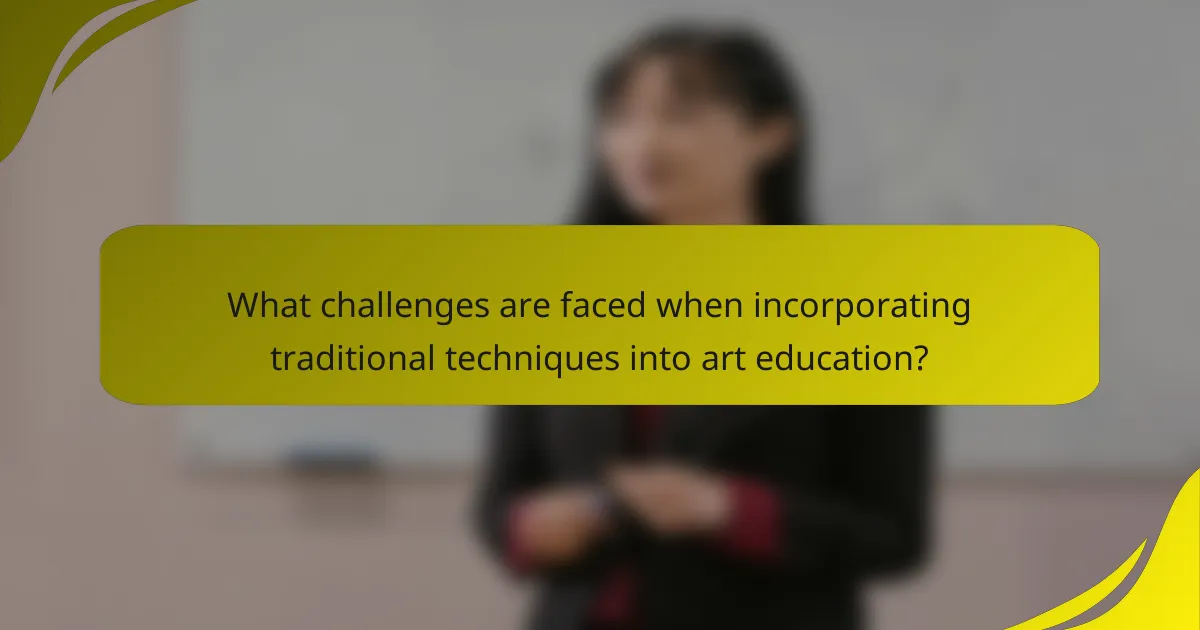
What challenges are faced when incorporating traditional techniques into art education?
Incorporating traditional techniques into art education faces several challenges. One significant challenge is the lack of resources and materials needed for traditional methods. Many institutions may not have access to specific tools or materials that are essential for these techniques. Additionally, there is often a shortage of qualified instructors who are proficient in traditional art forms. This can lead to a gap in knowledge transfer to students.
Another challenge is the perception of traditional techniques as outdated or less relevant in contemporary art education. Some educators may prioritize modern techniques over traditional ones, impacting the curriculum. Furthermore, students may struggle with the complexity and time-consuming nature of traditional methods, leading to frustration and disengagement.
Cultural factors also play a role. In regions like Palestine, the political and social context can influence the integration of traditional techniques. Art educators may face resistance from students or communities who prioritize contemporary expressions over traditional practices. Lastly, there is often a lack of institutional support for integrating traditional techniques into the broader art education framework, making it difficult to implement these practices effectively.
What are the barriers to integrating traditional techniques in modern curriculums?
Barriers to integrating traditional techniques in modern curriculums include a lack of resources and training. Many educators are not familiar with traditional methods. This gap in knowledge limits effective teaching. Additionally, modern curriculums often prioritize contemporary techniques and digital tools. This focus can overshadow traditional practices. Institutional resistance also plays a role. Schools may hesitate to change established curriculums. Limited funding further restricts the incorporation of traditional techniques. This financial constraint affects the availability of materials and workshops. Lastly, cultural perceptions may undervalue traditional art forms. These barriers collectively hinder the integration of traditional techniques in art education.
How can educators overcome these barriers?
Educators can overcome barriers in Palestinian art education by integrating traditional techniques into the curriculum. This approach fosters cultural identity and enhances student engagement. Training programs for teachers can provide essential skills in these techniques. Collaboration with local artists can bring authenticity to the learning experience. Access to resources and materials is crucial for effective implementation. Community involvement can support and sustain these educational initiatives. Studies show that culturally relevant education improves student outcomes and motivation. Engaging students in hands-on projects can deepen their understanding of traditional art forms.
What resources are available to support the integration of traditional techniques?
Resources available to support the integration of traditional techniques include educational programs, workshops, and online platforms. Educational programs often focus on traditional art forms and provide structured learning. Workshops led by experienced artisans offer hands-on experience with traditional techniques. Online platforms, such as webinars and video tutorials, facilitate access to expert knowledge. Local cultural institutions may also provide resources, including materials and mentorship. Additionally, community initiatives often promote traditional art practices through collaborative projects. Grants and funding opportunities may support projects aimed at preserving traditional techniques. These resources collectively enhance the integration of traditional techniques in Palestinian art education.
How can community involvement enhance the incorporation of traditional techniques?
Community involvement can significantly enhance the incorporation of traditional techniques in Palestinian art education. Engaging local communities fosters a deeper understanding of cultural heritage. This collaboration allows artists and educators to share knowledge and techniques passed down through generations. Community members can provide authentic insights and context, enriching the educational experience. Furthermore, participation encourages the preservation of these techniques, ensuring they are not lost over time. Studies show that community-driven projects often lead to increased interest and participation in traditional arts. For instance, initiatives that involve local artisans in teaching often result in higher engagement from students. This approach not only revitalizes traditional practices but also strengthens community bonds.
What role do local artists play in art education?
Local artists play a crucial role in art education by providing authentic cultural insights. They serve as mentors, sharing traditional techniques and practices. This direct engagement helps students connect with their heritage. Local artists also inspire creativity through hands-on workshops. Their presence fosters a deeper appreciation for local art forms. Research indicates that students benefit from learning directly from practitioners. For example, a study by the National Endowment for the Arts emphasizes the impact of local artists in educational settings. Their involvement enhances both artistic skills and cultural understanding among students.
How can workshops and community events support traditional techniques?
Workshops and community events can effectively support traditional techniques by providing hands-on learning experiences. These settings allow participants to engage directly with skilled artisans. This interaction fosters the transmission of knowledge across generations. Community events often showcase traditional arts, raising awareness and appreciation. Workshops can offer structured lessons in specific techniques, enhancing skill development. Research shows that such immersive experiences increase retention of traditional practices. For example, the “Cultural Heritage in Palestinian Art” study highlights the positive impact of community engagement on preserving traditional methods.
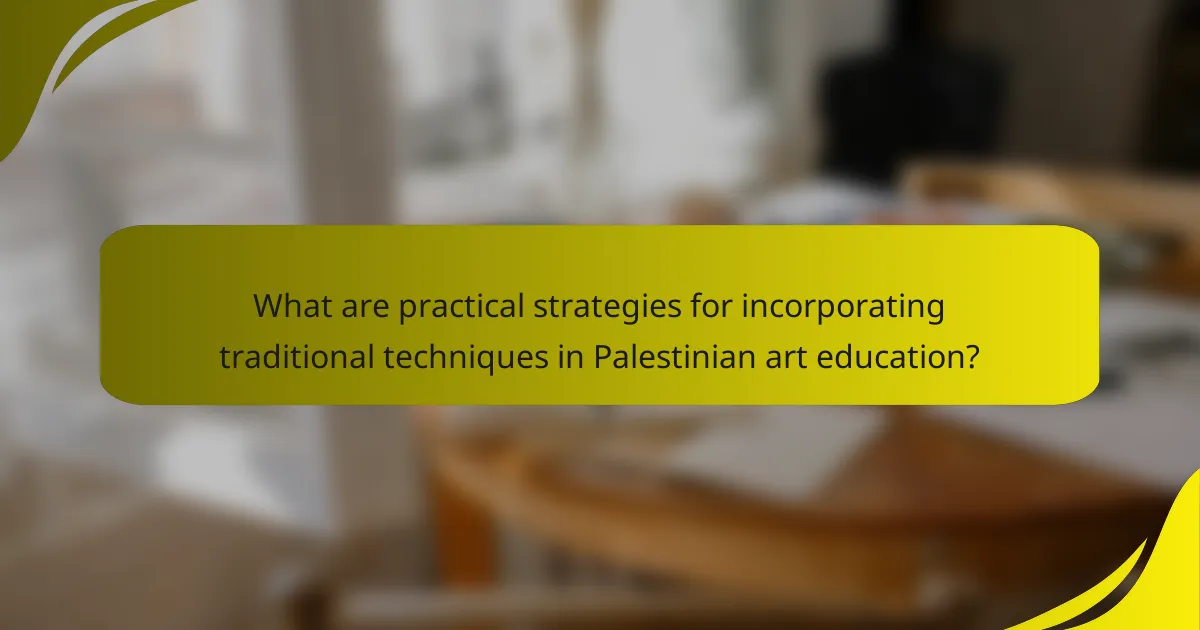
What are practical strategies for incorporating traditional techniques in Palestinian art education?
Integrating traditional techniques in Palestinian art education can be achieved through hands-on workshops. These workshops can focus on specific techniques such as pottery, weaving, and embroidery. Educators should invite local artisans to teach these skills directly to students. This method fosters a connection between students and their cultural heritage. Curriculum development should include historical context about traditional art forms. Field trips to local galleries or cultural sites can enhance understanding. Incorporating traditional materials in projects can deepen the learning experience. Collaborative projects with community members can also strengthen cultural ties. This approach not only preserves traditional techniques but also enriches students’ artistic expression.
How can educators effectively teach traditional techniques?
Educators can effectively teach traditional techniques by integrating hands-on practices into their curriculum. This approach allows students to engage directly with the materials and methods used in traditional art forms. Demonstrating techniques in real-time enhances understanding and retention. Utilizing local artists as guest instructors brings authenticity to the learning experience. Incorporating cultural context helps students appreciate the significance of the techniques. Providing resources, such as videos and tutorials, supports diverse learning styles. Regular feedback and encouragement foster a supportive learning environment. Research shows that experiential learning increases student engagement and mastery of skills.
What methods can be used to engage students in learning traditional techniques?
Interactive workshops can engage students in learning traditional techniques. Hands-on experiences allow students to practice skills in real-time. Incorporating storytelling can enhance understanding of cultural significance. Group projects foster collaboration and peer learning among students. Demonstrations by skilled artisans provide authentic insights into traditional methods. Field trips to cultural sites can inspire and contextualize learning. Utilizing digital tools for research can enrich students’ exploration of traditional techniques. These methods have been shown to increase student interest and retention in art education.
How can assessment of traditional techniques be approached in art education?
Assessment of traditional techniques in art education can be approached through a structured framework. This framework evaluates students’ understanding and application of these techniques. It involves formative assessments that focus on skill development over time. Students can be assessed through practical assignments that require the use of traditional methods. Peer reviews can also provide insights into their proficiency and creativity. Additionally, reflective journals can help students articulate their learning experiences. Research indicates that such assessments enhance critical thinking and artistic expression. Incorporating diverse evaluation methods ensures a comprehensive understanding of traditional techniques.
What best practices should be followed when teaching traditional techniques?
Best practices for teaching traditional techniques include hands-on practice, contextual learning, and mentorship. Hands-on practice allows students to engage directly with the materials and methods. Contextual learning connects techniques to cultural significance, enhancing understanding. Mentorship from experienced artisans provides guidance and inspiration. Incorporating storytelling can enrich the learning experience by linking techniques to historical narratives. Regular feedback helps students refine their skills and fosters a growth mindset. Collaborative projects encourage teamwork and creativity among students. Lastly, adapting teaching methods to diverse learning styles ensures all students can grasp traditional techniques effectively. These practices enhance the educational experience and preserve cultural heritage.
How can teachers create a supportive learning environment for traditional techniques?
Teachers can create a supportive learning environment for traditional techniques by fostering respect for cultural heritage. They should incorporate local art forms into the curriculum. This approach enhances students’ connection to their roots. Teachers can provide hands-on experiences with traditional materials and methods. Regular feedback and encouragement boost students’ confidence. Collaborative projects promote teamwork and shared learning. Creating a safe space for expression allows students to explore their creativity. Research indicates that culturally relevant education improves engagement and retention.
What are common pitfalls to avoid in teaching traditional techniques?
Common pitfalls to avoid in teaching traditional techniques include neglecting cultural context. Understanding the cultural significance of techniques is crucial for effective teaching. Another pitfall is overemphasizing technical skills at the expense of creativity. Students should be encouraged to express their individuality while learning. Failing to adapt teaching methods to different learning styles can hinder student engagement. Each student may require unique approaches to grasp traditional techniques. Additionally, overlooking feedback from students can result in missed opportunities for improvement. Regularly seeking input can enhance the learning experience. Lastly, not providing adequate resources for practice can limit skill development. Access to materials and space is essential for mastering traditional techniques.
What tips can be implemented for successful integration of traditional techniques?
Successful integration of traditional techniques in Palestinian art education can be achieved through several strategies. First, educators should provide hands-on workshops that immerse students in traditional practices. This method enhances understanding and appreciation of the cultural significance of these techniques. Second, incorporating local artisans as guest instructors can bridge the gap between theory and practice. Their expertise offers students authentic insights into traditional methods. Third, creating collaborative projects that combine traditional and contemporary art fosters innovation. This approach encourages students to explore their creativity while respecting heritage. Fourth, integrating traditional techniques into the curriculum across various subjects can promote interdisciplinary learning. This strategy allows students to see the relevance of traditional art in broader contexts. Lastly, utilizing digital platforms to showcase traditional artwork can engage a wider audience and preserve these techniques for future generations. These tips collectively support the successful integration of traditional techniques in Palestinian art education.
The main entity of the article is the incorporation of traditional techniques in Palestinian art education. The article outlines the benefits of these techniques, emphasizing their role in fostering cultural identity, enhancing creativity, and preserving heritage. It discusses specific traditional methods such as embroidery, pottery, and wood carving, and their impact on student engagement and artistic expression. Additionally, the article addresses challenges faced in integrating these techniques into modern curricula and offers practical strategies for educators to overcome barriers, enhance community involvement, and create supportive learning environments.
